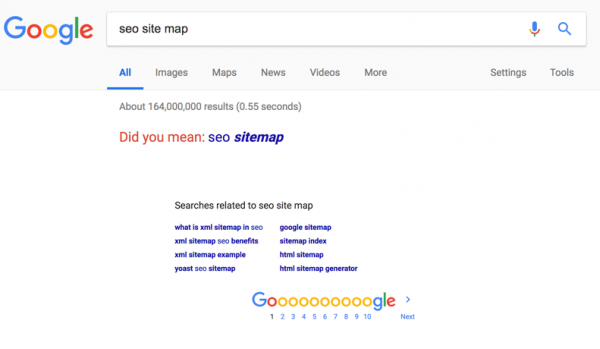
B2B Articles - September 18, 2018
A keyword strategy is a wonderful way to organize your search marketing activities. We advise that every company starts with a documented strategy before getting too far with content writing or anything else.
Google’s market share in 2017 was 75% of all keyword inquiries, according to Smart Insights.
So first, what is a keyword strategy?
A keyword strategy is a documentation of several keyword clusters you’d like to target. It includes focus keywords and also “long-tail” keywords that are related to the cluster. It also includes a content plan to achieve those goals, with action items like “write a blog post,” “publish SEO page,” or “optimize an existing page.” It’s something you can follow like a map and use to get your whole team on board.
So, how can you create a keyword strategy for yourself? Follow this step-by-step guide.
The first and most important thing you can do for your keyword strategy is to understand your target audience. What phrases and terminology are they using? Oftentimes, businesses rely too heavily on branded terms that describe their own products or methods -- however, these terms rarely work in a keyword strategy.
To audit keywords that will work for your audience, you should:
Don’t be afraid to rethink how you talk about your business and services. In fact, it’s very likely that keyword research will be eye-opening for you and will challenge you!
Many popular tools compete in the keyword space. Even though HubSpot sunset its tracking tool, many others have taken its place. You can use Agency Analytics to track keywords over time, Moz or Keywords Everywhere Chrome extensions to measure keyword metrics, and BuzzSumo, SEMrush, and SpyFu for more research.
Play around with those tools and see what makes you feel most comfortable and what also fits in your price range. However, one thing you must do is invest in a tool that will continually crawl your website and track your keyword progress over time. Agency Analytics is one such tool.
Next up, you must create a large database of keywords you want to research. Work on adding keywords that are wide-ranging into your tracking tool. Experiment with new phrasings even if you don’t use them already.
You don’t need to keep these terms in your tracking tool forever, but the more phrases you have, the bigger the sample size and the better judgment you will have. Try to add at least in the range of 50-100 keyword options.
Tip: Search a desired term in Google and see what comes up for related searches. These will often give you new ideas in your audience’s minds.

Next, pare down all of your keyword options into the very best targets. The best targets have:
You can find all of these analytics across the tools mentioned above. Keep note of all of these metrics in neat columns so you can reference them later.
Tip: Make a note of low, medium, and high priorities based on the analytics. Color coding can be helpful! Ask yourself: What are the very best and most relevant terms to my business that have enough volume to drive visitors to my website but aren’t so difficult that I can’t even make a dent? Those are high priorities!
Topic clusters (also called content clusters) are groupings of content around a similar topic. By writing content in clusters and hyperlinking them all together, you tell Google that you have wide and deep authority on a subject. This helps you rank in search.
Of your “high” priority keywords that you labeled, choose 1-2 that will serve as the centerpieces of your new topic clusters. Write these down.
Next, think of potential “long-tail” variations on these keywords. Long-tail keywords usually have less volume but are more specific. For example, “information technology” at the center might yield “IT service management,” “information technology definition,” and “IT manage best practices.” Write these down as well.
Tip: Notice that in the example above, we’re using variations on the center phrase. Google is getting smarter and can understand semantic similarities in keywords. So just write in a way that would make sense to your audience.
Next, come up with an action item for each keyword. If you are already ranking for that term, your action might be “add more website links pointing here” or “refresh and optimize the content for this keyword on this page.”
If you are not ranking for a target keyword, your action item will be “create SEO page,” which will be the center of your topic cluster.
Now that you’ve determined action items for your keyword strategy get to work! You should aim to publish at least one blog post a week or even twice a week if your industry is saturated with a lot of content. Refreshing old content with new keywords is also a great way to “recycle.” And you should also publish SEO pages often in your content marketing mix.
Tip: SEO pages are basically just landing pages that are targeted for a keyword. The keyword must be closely related to your business offering. Always include plenty of content on these pages, including rich images. And always include a form for conversion.

Remember to tie all of your content together with hyperlinks. Google likes to follow these paths like breadcrumbs to understand your knowledge on a topic.
Remember how we said you must be tracking keywords over time with a tool? This is really important. Periodically you need to check your progress over time:
The metrics here will tell you how to optimize your strategy. By refining over time, you will create a strong SEO presence that pulls in many new leads.
Sources
Smart Insights, 30 January 2018, “Search Engine Statistics 2018”
Tel 212-993-7809
Ironpaper ®
10 East 33rd Street
6th Floor
New York, NY 10016
Map
First-party data marketing
SEO for B2B
Customer journey strategy
ABM Agency
Marketing for IoT Companies
HubSpot Implementation
B2B Product Marketing
Measurable Marketing
IoT go-to-market strategy
IT Marketing
HubSpot for ABM
Go to market strategy
Technology Marketing
Marketing for IT Companies
ABM Campaigns
B2B lead generation
B2B Marketing and Growth Agency.
Grow your B2B business boldly. Ironpaper is a B2B marketing agency. We build growth engines for marketing and sales success. We power demand generation campaigns, ABM programs, create B2B content, strengthen sales enablement, generate qualified leads, and improve B2B marketing efforts.